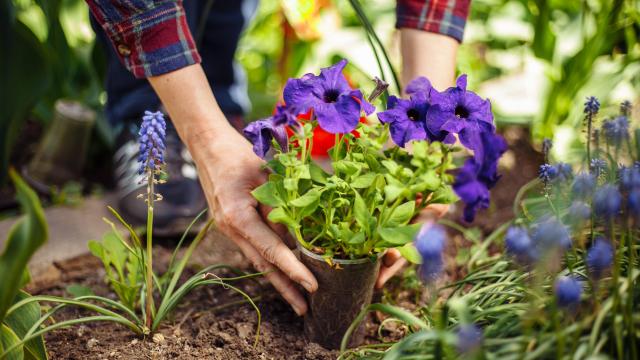You put a lot of work into your garden, so nothing is quite as frustrating as stepping back to take it all in and realising you’re not really happy the way it’s all arranged. Whether that has to do with aesthetics or more practical matters, like a certain plant needing to be in a sunnier spot, it’s daunting to imagine having to dig them all up and replant them. But you can design a garden that is more easily rearrange-able. Here’s how.
This method, found at Family Handyman, is not exactly inexpensive, so be warned you’ll be making some purchases here. You will need a bunch of pots, all the same size. More specifically, you’ll need at least double the amount of pots as you have plants. So, if you have 30 plants, you’ll need 60 pots.
Plant each flower or plant you think you. might want to move in your rearrangings in its own individual pot. In the garden, dig holes big enough to contain a pot and “plant” the number of pots that corresponds with the number of plants you have and will want to move around. The pots you stick in the ground should be deep enough that the rim is flush with the ground.
How to “rearrange” your garden
Take each of your potted plants and stick them in one of the pot-holes you made so there are two pots nested per plant. To hide the rims, use mulch and carefully arrange the leaves of your plants to create a more seamless look.
Whenever you want to rearrange the plants’ order or swap in a new flower, remove the top pot from your nested set and put it into another hole. This way, the plant itself doesn’t have to face the trauma of constant uprooting; it just goes where its home pot goes.
Of course, you can use pots of different sizes for bigger and smaller plants, but make sure they have a pot of the same size planted in the ground. As long as all your vessels come in groups of two, you’re good.
You can even swap in brand new plants in the middle of the season and use this trick to easily bring plants inside when it starts to get cold out. Just try to avoid doing this with plants that are going to quickly outgrow their pots or that need bigger root systems than a pot can provide. Plants like lavender and zinnias do especially well in shallow soil, for instance, so ask the team at your local nursery what they’d recommend for not only your climate and skill level.

Leave a Reply
You must be logged in to post a comment.